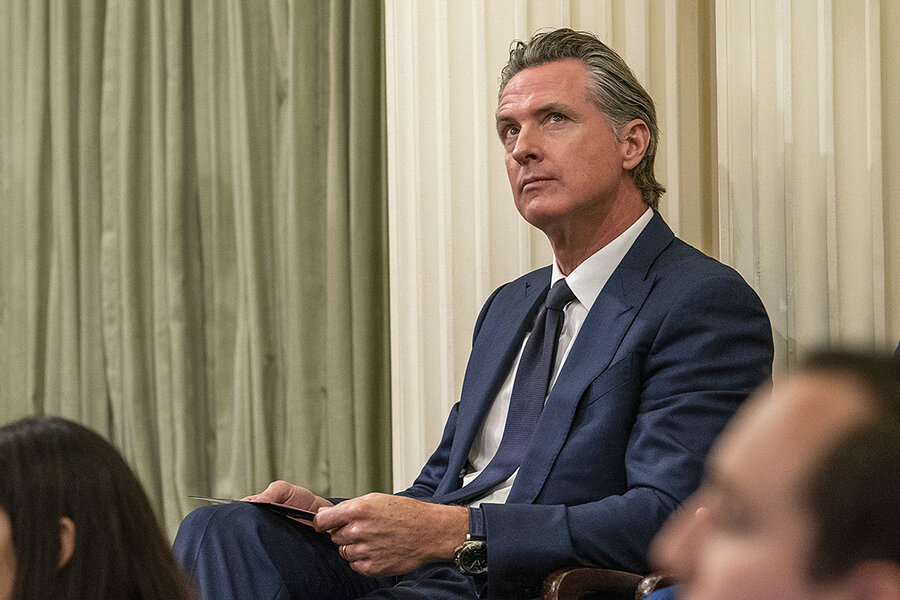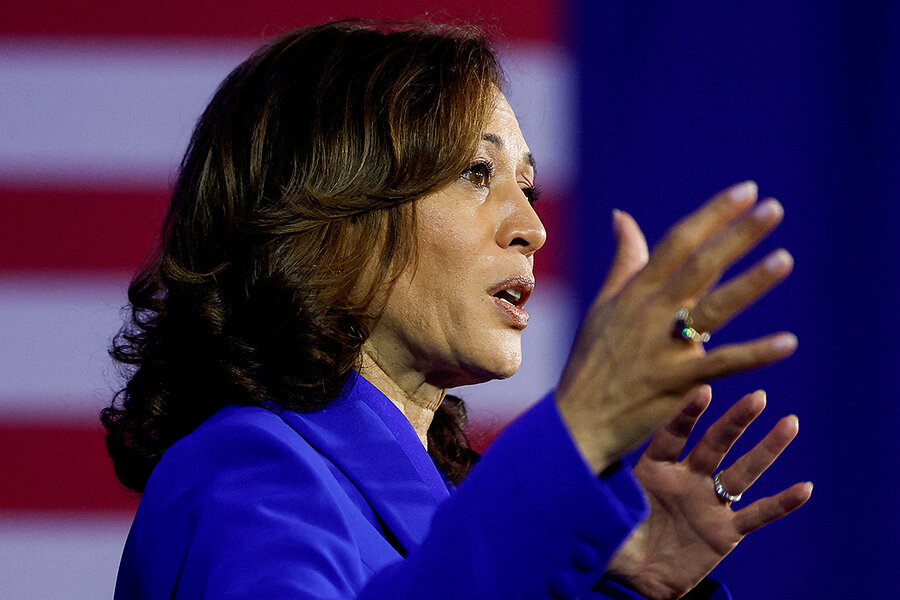Democrats prep shadow presidential campaigns
Loading...
| Washington
The 2024 Democratic presidential primary race officially features just President Joe Biden and two long shots, lawyer and vaccine skeptic Robert F. Kennedy Jr. and self-help author Marianne Williamson.
But mainstream Democrats with evident presidential aspirations are positioning themselves to run, either in 2024 – in case the octogenarian Mr. Biden can’t run or decides to drop out – or in 2028. This shadow presidential field features mostly popular governors, from California’s Gavin Newsom to Michigan’s Gretchen Whitmer, who have been busy fundraising for Democratic candidates, building national databases of supporters, and raising their profiles.
Why We Wrote This
Some ambitious Democratic governors appear to be laying the groundwork for presidential campaigns in case President Joe Biden can’t run or decides to drop out.
In some ways, Mr. Biden has only himself to blame for the speculation that he could change his mind on running for reelection. After all, during the 2020 presidential campaign he referred to himself as a “bridge” to a new “generation of leaders” and was generally noncommittal about whether, if elected, he would seek a second term.
As long as Mr. Biden is in the race, “it’s a campaign that has to stay in the shadows,” says veteran political analyst Charlie Cook. “But they have to be ready to pop out of the shadows if the circumstances change.”
Gavin Newsom, the Democratic governor of California, is hardly subtle.
He’s been traveling the country – especially red states – stumping for President Joe Biden, helping Democrats raise money, and highlighting liberal values on hot-button topics such as abortion and gay rights.
He’s plowed $10 million into a political action committee to support Democrats. He sparred with Fox News prime-time TV host Sean Hannity for an hour last month. He’s building a national database of supporters. And he’s been attacking top Republicans, from the 2024 primary front-runner, former President Donald Trump, to Florida Gov. (and presidential candidate) Ron DeSantis and Texas Gov. Greg Abbott.
Why We Wrote This
Some ambitious Democratic governors appear to be laying the groundwork for presidential campaigns in case President Joe Biden can’t run or decides to drop out.
But Governor Newsom insists he’s not running for president himself.
Gretchen Whitmer, the Democratic governor of Michigan, also says she’s not running for president. She, too, has launched a political action committee to help other Democrats, though unlike Mr. Newsom, she’s been sticking close to home. A national co-chair of President Biden’s reelection campaign, she’s attracting attention as if she is a presidential prospect, including a buzzy recent profile in Politico.
Then there’s J.B. Pritzker. The billionaire Democratic governor of Illinois helped Chicago secure the 2024 Democratic National Convention. If Mr. Biden were to suddenly drop out of the race, Governor Pritzker would certainly be seen as a possible contender – though a source close to Governor Pritzker’s team suggests he probably wouldn’t run, out of deference to Vice President Kamala Harris.
Such is the state of the 2024 Democratic presidential primary race – officially featuring just Mr. Biden and two long shots, lawyer and vaccine skeptic Robert F. Kennedy Jr. and self-help author Marianne Williamson.
But mainstream Democrats with evident presidential aspirations are positioning themselves to run, either in 2024 – in case the octogenarian Mr. Biden can’t run or decides to drop out – or in 2028. The “shadow presidential field,” populated by people now in their 50s, is coming into view.
As long as Mr. Biden is in the race, “it’s a campaign that has to stay in the shadows,” says veteran political analyst Charlie Cook. “But they have to be ready to pop out of the shadows if the circumstances change.”
“Newsom is the most blatant,” he adds.
Mr. Newsom, of course, isn’t every Democrat’s cup of tea, with the slick California vibe and an embarrassing pandemic-era episode he may never live down: dining out at the exclusive French Laundry restaurant right after warning Californians not to gather for the holidays.
But in his attacks on leading Republicans – including going after Governor DeSantis for flying migrants to California – Mr. Newsom is demonstrating that he’s a fighter, a quality that voters often like.
“Gavin Newsom has figured out that, in addition to potentially helping his national prospects, it’s a very helpful way of rallying his base back home,” says Dan Schnur, a former Republican strategist based in California. “Not all Democrats here agree on the best solution for housing or education or climate change, but they all agree that they can’t stand Ron DeSantis.”
Still, Governor Whitmer of battleground Michigan may be running a more effective shadow presidential campaign by being less obvious, Mr. Cook says. Her reelection sweep last November, ushering in total Democratic control of her state’s government for the first time since 1983 – and aided by a ballot measure securing statewide abortion rights – may be the best advertisement of her political skill.
Ms. Whitmer, too, may have earned some toughness points, after the FBI cracked a plot in 2020 by a Michigan militia group planning to kidnap her and overthrow the state government.
In some ways, Mr. Biden has only himself to blame for the speculation that he could change his mind on running for reelection. After all, during the 2020 presidential campaign he referred to himself as a “bridge” to a new “generation of leaders” and was generally noncommittal about whether, if elected, he would seek a second term.
One longtime Democratic strategist, speaking anonymously in order to be candid, says that for prominent Democrats, “it’s a smart move to keep longer-term options open” – i.e., lay the groundwork for 2028. As for a 2024 scenario in which Mr. Biden ends up not running, “Vice President Harris would presumably lead the ticket,” this strategist says. “Others should defer to her.”
But many outside observers aren’t so sure, seeing a long list of potential Democratic presidential prospects who might choose to run in a Biden-less 2024, including senators and others who ran for the 2020 nomination – as well as some fresh faces, such as the new governor of Pennsylvania, Josh Shapiro.
Mr. Cook, for one, doesn’t see ambitious Democrats deferring to Ms. Harris in the event Mr. Biden ends up not running. “I don’t think she’s a pushover, but I don’t see many staying out because of her,” he says.
Ms. Harris’ early struggles as vice president have been well documented, some of her own making, and some not. Supporters say she faced a steep learning curve, with a portfolio of tough issues, including the southern border, and extra scrutiny as a woman of color.
But Mr. Biden has stuck by Ms. Harris, making her his administration’s lead advocate on reproductive rights – an issue she knows well and that is highly energizing for Democrats – and featuring her prominently in his reelection launch video. Key supporters, too, are swinging into action. The group Emily’s List, which helps elect women in favor of abortion rights, has launched a $10 million campaign to boost Ms. Harris’ public standing.
The vice president is already popular with Black voters, a core Democratic constituency, at 64% approval in a recent Economist/YouGov poll.
Overall, though, Ms. Harris – like Mr. Biden – suffers from low job approval ratings. Both are at around 40%.
“Part of the problem is that the vice presidency is a terrible job,” says Chris Galdieri, a political scientist at Saint Anselm College in Goffstown, New Hampshire. “When the president is unpopular, the vice president is unpopular.”
Beyond the low job approval, Ms. Harris also has high negatives. A recent NBC News poll found her with 32% positive and 49% negative ratings among registered voters, for a net negative of 17 percentage points – a record for that poll.
Add to that the fact that Ms. Harris is the understudy to an older president who at times can appear less than physically robust. Republicans are certain to go after her as the 2024 race heats up, essentially arguing that reelecting Mr. Biden risks winding up with President Harris.
The good news for Democrats heading into 2024 is that party leaders are united around the Biden-Harris ticket. It’s the Republicans who have a big, messy primary field, with a highly controversial front-runner, Mr. Trump. Usually, the saying goes, it’s the Republicans who fall in line.
Democrats are also demonstrating that they have a “bench.” Not only are there alternate candidates seemingly ready to go for 2024; if need be, there’s a growing list of prospects for 2028, including Governor Shapiro and Gov. Wes Moore of Maryland, the nation’s only Black governor.










